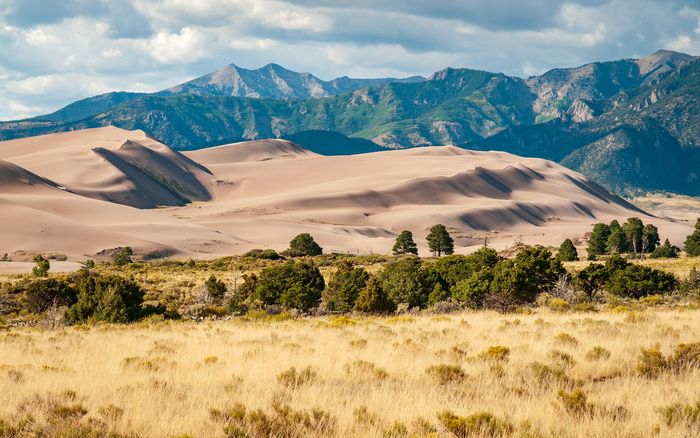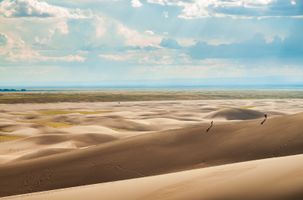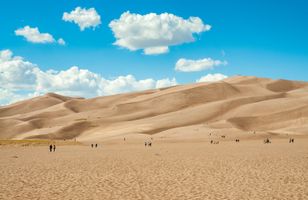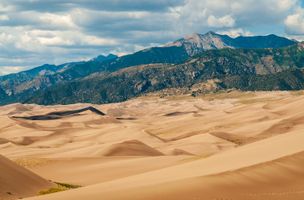Great Sand Dunes National Park - map, photos and other informations
Table of Contents
Description
Great Sand Dunes National Park and Preserve is a unique park located in the San Luis Valley of south-central Colorado. It is the nation’s highest sand dune field, with dunes towering up to 750 feet above the valley floor. The park was established in 1932 as a national monument to protect the unique natural environment and the diverse species of plants, mammals, birds, and other animals that call it home. Great Sand Dunes was established as a national park in 2004.
The park encompasses more than 149,000 acres and includes alpine lakes, grasslands, wetlands, and the spectacular 45,000-acre dune field. The park is home to many rare and endangered species, including the threatened Mexican spotted owl and the endangered boreal toad.
The park features a variety of recreational opportunities, including hiking, backpacking, camping, fishing, and horseback riding. A number of interpretive programs and ranger-led activities, such as guided hikes and evening campfire programs, are also offered throughout the year.
The naturally-occurring sand dunes cover an estimated 30 square miles and are some of the tallest sand dunes in North America. The dunes are constantly shifting, with some reaching heights of up to 750 feet. The dunes are a popular spot for sledding, sand sledding, and sandboarding.
The Great Sand Dunes Visitor Center offers interactive exhibits about the park’s natural history, ecology, and human history. The center also offers a gift shop and a wide range of educational programs and activities.
The park’s Medano Creek is a magnificent natural feature that flows through the dunes and is fed by snowmelt from the nearby Sangre de Cristo Mountains. Its shallow, sandy bottom makes it a perfect spot for wading, swimming and tubing.
Located nearby is the Zapata Falls, a magnificent and picturesque waterfall surrounded by lush pine forests, aspen, and meadows. This spectacular site can be reached via a short, easy trail.
For visitors interested in learning more about the area’s history, the Great Sand Dunes Oasis Visitor Center offers detailed exhibits about the region’s ancient cultures and its role in the westward expansion of the United States. There are also several archaeological sites in the park, including ancient Native American petroglyphs and pueblos.
The park is a prime destination for wildlife viewing. The Great Sand Dunes is home to dozens of species of birds, including some of the rarest in North America. Other wildlife that can be seen include coyotes, elk, mule deer, porcupine, bighorn sheep, and black bears.
Whether you’re looking for an outdoor adventure, a peaceful retreat, or a chance to learn about the area’s history and ecology, Great Sand Dunes National Park and Preserve has something for everyone.
Photos of Great Sand Dunes National Park
Frequently Asked Questions (FAQ) about Great Sand Dunes National Park
Where is Great Sand Dunes National Park located?
Great Sand Dunes National Park is located in the San Luis Valley of Colorado, about 4 hours south of Denver, 2 hours north of Santa Fe, New Mexico, and 1 hour east of Alamosa.
How did the Great Sand Dunes form?
The Great Sand Dunes of Colorado were formed by wind and water erosion of the nearby Sangre de Cristo Mountains. Over time, sediment from the mountains was transported by wind and water to the base of the mountains, creating a large, flat area of sand. The prevailing westerly winds then shaped the sand into the large dunes we see today.
Is Great Sand Dunes National Park worth it?
For sure! Great Sand Dunes National Park is definitely worth a visit. With its towering sand dunes and spectacular views, it is a great place for outdoor recreation and exploration. The park also offers a variety of activities, from sand sledding and sand-boarding to backpacking and wildlife watching.
How to get to Great Sand Dunes National Park?
Great Sand Dunes National Park is located in southern Colorado, and is accessible via car or public transportation. To get there by car, take Highway 285 from either Denver or Santa Fe, New Mexico. If you’re taking public transportation, you can take a Greyhound bus to Alamosa, Colorado, which is about 25 miles from the park. From there, you can catch a local bus to the park.
Average weather in Great Sand Dunes National Park
|
|
|
|
|
|
|---|---|---|---|---|
| Jan | -2 °C 28 °F | -14 °C 7 °F | 0 mm 0.0 in | 15 mm 0.6 in |
| Feb | 0 °C 32 °F | -13 °C 9 °F | 1 mm 0.0 in | 23 mm 0.9 in |
| Mar | 5 °C 41 °F | -8 °C 18 °F | 3 mm 0.1 in | 22 mm 0.9 in |
| Apr | 9 °C 48 °F | -4 °C 25 °F | 13 mm 0.5 in | 23 mm 0.9 in |
| May | 14 °C 57 °F | 1 °C 34 °F | 45 mm 1.8 in | 15 mm 0.6 in |
| Jun | 22 °C 72 °F | 7 °C 45 °F | 36 mm 1.4 in | 0 mm 0.0 in |
| Jul | 23 °C 73 °F | 10 °C 50 °F | 105 mm 4.1 in | 0 mm 0.0 in |
| Aug | 22 °C 72 °F | 9 °C 48 °F | 67 mm 2.6 in | 0 mm 0.0 in |
| Sep | 19 °C 66 °F | 6 °C 43 °F | 33 mm 1.3 in | 3 mm 0.1 in |
| Oct | 12 °C 54 °F | -1 °C 30 °F | 15 mm 0.6 in | 9 mm 0.4 in |
| Nov | 5 °C 41 °F | -6 °C 21 °F | 2 mm 0.1 in | 16 mm 0.6 in |
| Dec | -1 °C 30 °F | -12 °C 10 °F | 0 mm 0.0 in | 17 mm 0.7 in |
Other parks nearby
-
Lathrop State Park37.6 mi (60.4 km)|state park
-
Arkansas Headwaters Recreation Area49.8 mi (80.1 km)|state park
-
Lake Pueblo State Park54.6 mi (87.8 km)|state park
-
Trinidad Lake State Park65.5 mi (105.4 km)|state park
-
Browns Canyon National Monument68.0 mi (109.5 km)|national monument
User Reviews
Share your experience! Your honest feedback helps others make informed decisions.
Login to add new review




